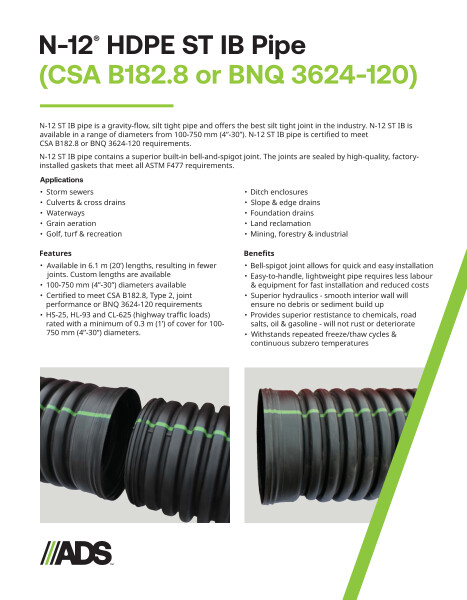Canada N-12 ST CSA B182.8 or BNQ 3624-120 Product Sheet
Filename:
Canada N-12 ST CSA B182.8 or BNQ 3624-120 Product Sheet.pdf

The N-12® ST IB pipe (per CSA B182.8) sell sheet explains the applications, features and benefits, and gives the specifications for the pipe. N-12 ST IB pipe contains a superior built-in bell-and-spigot joint. The joints are sealed by high-quality, factory-installed gaskets that meet all ASTM F477 requirements.
N-12 ST IB pipe (per CSA B182.8) is used for storm sewers, culverts & cross drains, waterways, grain aeration, golf, turf & recreation, ditch enclosures, slope & edge drains, foundation drains, land reclamation, and mining, forestry, industrial uses.
Features of the N-12 ST IB pipe include it is available in 6 m (20’) lengths which result in fewer joints, 100-1500 mm (4”-6”) diameters are available, it is certified to meet CSA B182.8, Type 2, silt tight joint performance requirements.
The benefits are that the bell-spigot joint offers quick & easy installation, the easy-to-handle, lightweight pipe requires less labour & equipment for fast installation and reduced costs. The superior hydraulics with a smooth interior wall ensures no debris or sediment builds up. N-12 ST IB pipe provides superior resistance to chemicals, road salts, oil & gasoline - it will not rust or deteriorate. The pipe withstands repeated freeze and thaw cycles & continuous sub-zero temperatures.
This document includes specifications for the Canada N-12 ST IB pipe (per CSA B182.8), including the scope. The specification describes 100 to 1500 mm (4”-60”) ADS Canada N-12 ST IB (per CSA B182.8) pipe for use in gravity-flow drainage applications. The specification includes information about the pipe requirements, joint performance, material properties, and installation.
For complete installation guidelines for Canada N-12 ST IB pipe (per CSA B182.8), follow CSA B182.11 published installation guidelines. Backfill for minimum cover situations shall consist of Class 1, Class 2 (minimum 90% SPD) or Class 3 (minimum 95% SPD) material. Maximum fill heights depend on embedment material and compaction level; please refer to Technical Note 2.01C.
